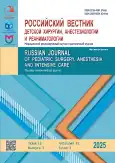A new osteotomy technique for the treatment of children with bladder exstrophy: a case series
- Authors: Kagantsov I.M.1,2, Kruglov I.Y.1, Baskov V.E.3, Agzamkhodzhaev S.T.4,5, Abdullaev Z.B.4,5, Aliyev T.G.4,5, Dubrov V.I.6, Pelikh K.I.1,7
-
Affiliations:
- Almazov National Medical Research Center
- Turner National Medical Research Center for Children’s Orthopedics and Trauma Surgery
- North-Western State Medical University named after I.I. Mechnikov
- National Children’s Medical Center
- Tashkent Pediatric Medical Institute
- 2nd City Children’s Clinical Hospital Minsk
- Children’s City Hospital No. 22, Saint Petersburg
- Issue: Vol 15, No 3 (2025)
- Pages: 349-356
- Section: Original Study Articles
- URL: https://medbiosci.ru/2219-4061/article/view/343614
- DOI: https://doi.org/10.17816/psaic1919
- EDN: https://elibrary.ru/DUMYUY
- ID: 343614
Cite item
Full Text
Abstract
BACKGROUND: Bladder exstrophy is a rare congenital urological anomaly affecting the bladder, genitalia, pelvic floor, and pelvic bones. Skeletal abnormalities associated with bladder exstrophy include external rotation of the iliac bones, shortening and hypoplasia of the pubic rami, and retroversion of the acetabulum. The main challenge in defect closure is pubic diastasis.
AIM: The work aimed to present a novel pelvic osteotomy technique for the treatment of bladder exstrophy.
METHODS: The study included 30 patients with classical bladder exstrophy who underwent pelvic osteotomy using the proposed technique. The cohort comprised 24 boys and 6 girls, aged from 1 day to 17 years, operated in various clinics in St. Petersburg (Russia), Tashkent (Uzbekistan), and Minsk (Belarus).
RESULTS: After 30 surgical procedures for classical bladder exstrophy with pelvic osteotomy performed according to our technique in children aged from 1 day to 17 years, a complication occurred in only one case—postoperative wound infection—which was treated conservatively using broad-spectrum systemic antibiotics and local therapy. This complication occurred in the group of patients who underwent reoperation after prior surgical bladder repair without pelvic osteotomy. No patient developed an increase in pubic diastasis in the postoperative period.
CONCLUSION: The proposed pelvic osteotomy technique is effective for abdominal wall closure and bladder reconstruction. This is confirmed by the low complication rate (3.3%), involving both orthopedic and urological aspects, as well as the absence of postoperative pubic diastasis in all patients. Moreover, this pelvic osteotomy technique is an effective procedure due to its excellent correction of the disrupted pelvic ring and preservation of this correction.
Full Text
##article.viewOnOriginalSite##About the authors
Ilya M. Kagantsov
Almazov National Medical Research Center; Turner National Medical Research Center for Children’s Orthopedics and Trauma Surgery
Email: ilkagan@rambler.ru
ORCID iD: 0000-0002-3957-1615
SPIN-code: 7936-8722
MD, Dr. Sci. (Medicine)
Russian Federation, Saint Petersburg; Saint PetersburgIgor Yu. Kruglov
Almazov National Medical Research Center
Email: dr.gkruglov@gmail.com
ORCID iD: 0000-0003-1234-1390
SPIN-code: 7777-1047
Russian Federation, Saint Petersburg
Vladimir E. Baskov
North-Western State Medical University named after I.I. Mechnikov
Email: dr.baskov@mail.ru
ORCID iD: 0000-0003-0647-412X
SPIN-code: 1071-4570
MD, Cand. Sci. (Medicine)
Russian Federation, Saint PetersburgSaidanvar T. Agzamkhodzhaev
National Children’s Medical Center; Tashkent Pediatric Medical Institute
Email: ast.doctor@gmail.com
ORCID iD: 0000-0003-0742-7392
SPIN-code: 6553-0725
MD, Dr. Sci. (Medicine)
Uzbekistan, Tashkent; TashkentZafar B. Abdullaev
National Children’s Medical Center; Tashkent Pediatric Medical Institute
Email: abdullaev.med@gmail.com
ORCID iD: 0000-0002-8410-6552
SPIN-code: 2046-3431
MD, Cand. Sci. (Medicine)
Uzbekistan, Tashkent; TashkentTalat G. Aliyev
National Children’s Medical Center; Tashkent Pediatric Medical Institute
Email: tgafurovich@gmail.com
ORCID iD: 0000-0003-2767-3435
Uzbekistan, Tashkent; Tashkent
Vitalii I. Dubrov
2nd City Children’s Clinical Hospital Minsk
Email: dubroff2000@mail.ru
ORCID iD: 0000-0002-3705-1288
SPIN-code: 5833-4928
MD, Dr. Sci. (Medicine), Assistant Professor
Belarus, MinskKirill I. Pelikh
Almazov National Medical Research Center; Children’s City Hospital No. 22, Saint Petersburg
Author for correspondence.
Email: dr.pelikh@yandex.ru
ORCID iD: 0000-0001-8064-1315
SPIN-code: 1010-3851
Russian Federation, Saint Petersburg; Saint Petersburg
References
- Pathak P, Ring JD, Delfino KR, et al. Complete primary repair of bladder exstrophy: a systematic review. J Pediatr Urol. 2020;16(2):149–153. doi: 10.1016/j.jpurol.2020.01.004
- Khandge P, Wu WJ, Hall SA, et al. Osteotomy in the newborn classic bladder exstrophy patient: A comparative study. J Pediatr Urol. 2021;17(4):482.e1–482.e6. doi: 10.1016/j.jpurol.2021.04.009
- Castagnetti M, Gigante C, Perrone G, Rigamonti W. Comparison of musculoskeletal and urological functional outcomes in patients with bladder exstrophy undergoing repair with and without osteotomy. Pediatr Surg Int. 2008;24(6):689–693. doi: 10.1007/s00383-008-2132-x
- Kantor R, Salai M, Ganel A. Orthopaedic long term aspects of bladder exstrophy. Clin Orthop Relat Res. 1997;335:240–245. doi: 10.1097/00003086-199702000-00024
- Sponseller PD, Jani MM, Jeffs RD, Gearhart JP. Anterior innominate osteotomy in repair of bladder exstrophy. J Bone Joint Surg Am. 2001;83(2):184–193. doi: 10.2106/00004623-200102000-00005
- Grady RW, Mitchell ME. Complete primary repair of exstrophy. J Urol. 1999;162(4):1415–1420. doi: 10.1016/S0022-5347(05)68327-9
- Wild AT, Sponseller PD, Stec AA, Gearhart JP. The role of osteotomy in surgical repair of bladder exstrophy. Semin Pediatr Surg. 2011;20(2):71–78. doi: 10.1053/j.sempedsurg.2010.12.002
- Patent RU 2802430/ 28.08.2023. Kruglov IYu, Baskov VE, Kagantsov IM, Pervunina TM. Method of surgical correction of the pelvic ring for the treatment of bladder exstrophy in children. (In Russ.) EDN: MCDMJQ
- Baka-Ostrowska M, Kowalczyk K, Felberg K, Wawer Z. Complications after primary bladder exstrophy closure — role of pelvic osteotomy. Cent Eur J Urol. 2013;66(1):104–108. doi: 10.5173/ceju.2013.01.art31
- Alshryda S, Majid I, Jaber G, et al. The Y-pelvic osteotomy in treating bladder exstrophy: a surgical technique. Cureus. 2022;14(10):e30520. doi: 10.7759/cureus.30520
- Frey P, Cohen SJ. Anterior pelvic osteotomy. A new operative technique facilitating primary bladder exstrophy closure. Br J Urol. 1989;64(6):641–643. doi: 10.1111/j.1464-410x.1989.tb05327.x
- Stec AA, Pannu HK, Tadros YE, et al. Pelvic floor anatomy in classic bladder exstrophy using 3-dimensional computerized tomography: initial insights. J Urol. 2001;166(4):1444–1449. doi: 10.1016/S0022-5347(05)65805-3
- Segev E, Ezra E, Binyamini Y, et al. A combined vertical and horizontal pelvic osteotomy approach for repair of bladder exstrophy: the Dana experience. Isr Med Assoc J. 2004;6(12):749–752.
- Salter RB, Dubos J-P. The first fifteen year’s personal experience with innominate osteotomy in the treatment of congenital dislocation and subluxation of the hip. Clin Orthop Relat Res. 1974;98:72–103. doi: 10.1097/00003086-197401000-00009
- Montagnani CA. Functional reconstruction of exstrophied bladder. Timing and technique. Follow-up of 39 cases. Z Kinderchir. 1988;43(5):322–330. doi: 10.1055/s-2008-1043477
- Gökçora IH, Yazar T. Bilateral transverse iliac osteotomy in the correction of neonatal bladder extrophies. Int Surg. 1989;74(2):123–125.
Supplementary files











